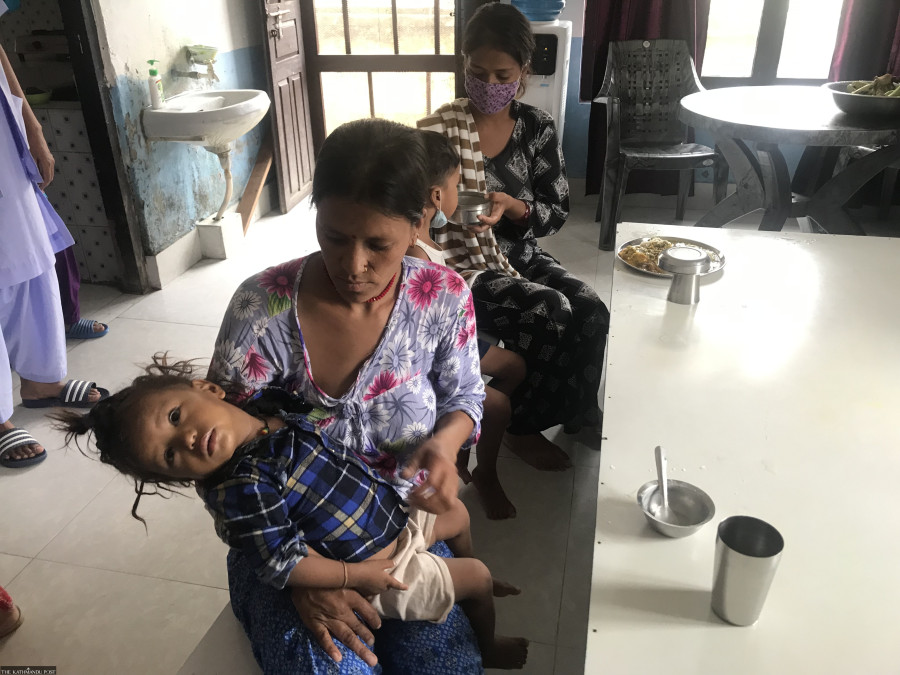Sudurpaschim Province
Malnutrition a cause for concern in Sudurpaschim
As per a 2016 survey, 36 percent of children under five were stunted, nine percent wasted, and 28 percent of children were underweight in the Province.
Arjun Shah
Jayamati Bohara, a resident of Bitthadchir Rural Municipality in Bajhang district, visited the local Deulek Health Post last month after her son started losing weight and became sickly. The two-year-old boy weighed just six kilograms and his height was measured 75 centimetres during a health check-up at a local health facility.
Health workers referred the boy to Dhangadhi, the provincial headquarters of Sudurpaschim, stating that he suffered from severe acute malnutrition.
Following the instruction of the health workers, Jayamati took her ailing son to Dhangadhi in August third week for treatment. The boy was admitted to the Nutrition Rehabilitation Home at Seti Provincial Hospital. He was discharged after receiving a three week-long treatment at the hospital.
Malnutrition in children is a province-wide issue in Sudurpaschim. Children from remote areas like Bitthadchir to those in the provincial headquarters of Dhangadhi suffer from malnutrition albeit in various degrees.
In Darchula, after carrying out health checks on 8,824 children aged six months to five years, as many as 866 children were found suffering from malnutrition till Friday, according to the District Health Office.
“The number seemed unreal; it was too high. We didn’t account for such a large number of children living with malnourishment. The situation of several impoverished communities in rural areas of Tarai is even worse,” said Birendra Bhatta, nutrition focal person at the District Health Office in Darchula.
Eight out of 20 children of Muktikot in Bajura, who were brought to the mobile vaccination centre last week, were found suffering from severe malnutrition.
In Kailali, as many as 12,207 children—which is around 14 percent of the total children population in the district—are wasted. According to the District Health Office, 486 children were found suffering from severe acute malnutrition in Kailali in the fiscal year 2019/20 while the number was 233 in the fiscal year 2020/21.
According to the Health Management Information System, 1,308 children were found suffering from severe acute malnutrition in nine districts of Sudurpaschim Province in the last fiscal year.
However, health workers say that the number could be even more since most cases of malnourishment in children are not on record.
Health coordinator at Saipal Rural Municipality Jaya Raj Joshi said that the local unit has not been able to collect data of malnourished children from far-flung areas.
“We haven’t been able to identify all malnourished cases in the remote areas,” said Joshi, health coordinator at Saipal Rural Municipality. “Some villages are too far and unreachable.”
Dr Gunaraj Awasthi, the provincial health directorate, admits that the data recording of both the Ministry of Social Development and the Department of Health Services is inconsistent and mismanaged.
“Health posts are under the jurisdiction of local units, and hospitals and district-based health institutions fall under the jurisdiction of the District Health Office. The data collecting system goes through a long process and there is a lack of communication among different health authorities,” said Awasthi.
The data of Nepal Demographic and Health Survey show that the nutrition level of the province has been falling every year, according to Gyanendra Dawadi, the nutrition coordinator of the Policy and Plan Commission Office in Sudurpaschim.
“This is not a good symptom,” Dawadi said.
According to the Nepal Demographic and Health Survey of 2016, 36 percent of children under five were stunted, nine percent wasted, and 28 percent of children were underweight in Sudurpaschim Province.
Dawadi says one of the leading causes of malnutrition among children is poverty.
In Bajura, the recent study of the Ministry of Land Management, Cooperatives and Poverty Alleviation showed that 71.1 percent of the population in the district is living under poverty. Out of 21,711 households, 6,393 families are living under extreme poverty, the study showed.
Janak Rokaya, ward chairman of Swamikartik Khapar Rural Municipality-1, says that most households in the local unit have difficulty managing two meals a day.
“When the whole family is hungry, the nutrition level in children becomes less of a priority. A majority of the children are malnourished here but no proper study has been conducted on the matter,” Rokaya said.
Rana BK of Muktikot in Swamikartik Rural Municipality of Bajura, a remote hill district where a majority of people live below the poverty line, has 16 children. His neighbour Angalal BK’s wife, who is in her late forties, recently gave birth to her 12th child. According to the local health workers, most of the children and mothers in the settlement are malnourished.
“Life is difficult in the villages and children do not get proper food or care in their infancy, leading to malnourishment,” said Badri Shahi, in-charge of the Health Post in Barku of Swamikartik Khapar Rural Municipality.
According to the Multidimensional Poverty Index Report 2021 released by the National Planning Commission on Wednesday, there is 25.3 percent multidimensional poverty in the Far West.
“Harmful eating habits of the locals with no priority to nutrition and a lack of effective research on the part of the authorities have contributed to malnutrition in children,’ said Awasthi, the provincial health directorate.
According to Awasthi, the diet of expecting and new mothers do not include food with high nutritional value, which hampers the health of the mother and her newborn.
Chitra Paneru, a women’s rights activist, pointed out that the heavy workload of women, poor condition of drinking water and sanitation, and gender inequality are also seriously affecting the health of women and children in rural areas.
According to the National Nutrition Strategy 2077, proper nutrition is required for the development of the fetus during pregnancy and then on to infancy, childhood, adolescence, adulthood and reproductive age.
To improve nutrition, the government has provided Rs 400 monthly nutritional allowances for all children from the Dalit community and in the hilly districts of Bajhang, Bajura, Achham and Baitadi. But health workers believe that the amount meant to feed nutritious food to children is not being used as intended.
“Poor families use the money to meet their household expenses,” said Deepak Shah, health coordinator of Bajura's Budhiganga Municipality. “That’s why it’s hard to eradicate malnourishment in poor families.”
Several government authorities and non-governmental organisations have been working in Sudurpaschim Province for years to improve the situation of malnutrition in children.
It has been nine years since the National Planning Commission launched a multi-sector nutrition plan to improve the nutrition level in children.
Mohandev Bista, member of the Policy and Planning Commission of Sudurpaschim Province, said that around Rs 190.6 million was spent on the nutrition programme in the province in the last fiscal year.
“Around Rs 600 million was spent to improve the nutrition level of children in the past four years,” said Bista.
The multi-sector nutrition plan has been running a nutrition improvement programme in every local unit of all nine districts of the province. According to Gyanendra Dawadi, the province coordinator of the project, one nutrition volunteer has been working in each local unit to coordinate and facilitate with the stakeholders.
In Sudurpaschim Province, three nutrition rehabilitation centres are currently in operation on the premises of Seti Provincial Hospital in Dhangadhi, Mahakali Provincial Hospital in Kanchanpur and Dadeldhura Hospital.
In the last fiscal year, 114 severely acute malnourished children received treatment in Seti, 113 received treatment in Mahakali and 63 in Dadeldhura hospitals.
There are only 10 beds each in the rehabilitation centres of Seti and Mahakali. Geeta Bista, in charge at Seti rehabilitation home, said, “Sometimes, malnourished children have to wait their turn for treatment due to the shortage of beds. We would be able to treat more children if we increase the bed capacity.”
According to the Provincial Health Directorate, 145 outpatient departments for malnourished children have been established in nine districts of Sudurpaschim Province.
“Malnourished children receive treatment and nutritious food from these departments. If children cannot be treated there, they will be referred to the rehabilitation centres in Dhangadhi, Mahendranagar and Dadeldhura for further treatment,” said Minraj Joshi, nutrition focal person of the health directorate.




 7.12°C Kathmandu
7.12°C Kathmandu












